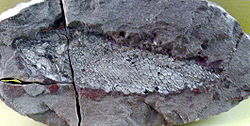- Osteolepis
-
Osteolepis
Temporal range: Middle Devonian
Osteolepis macrolepidotus fossil at the Museum für Naturkunde, Berlin Scientific classification Kingdom: Animalia Phylum: Chordata Subphylum: Vertebrata Class: Sarcopterygii Infraclass: Tetrapodomorpha Superorder: Osteolepidida Order: Osteolepiformes Family: Osteolepidae Genus: Osteolepis Osteolepis ('bone scale') is an extinct genus of lobe-finned fish from the Devonian period. It lived in the Orcadian Lakes of northern Scotland.
Osteolepis was about 20 centimetres (7.9 in) long, and covered with large, square scales. The scales and plates on its head were covered in a thin layer of spongy, bony material called cosmine. This layer contained canals which were connected to sensory cells deeper in the skin. These canals ended in pores on the surface, and were probably for sensing vibrations in the water.[1]
Osteolepis was a rhipidistian, having a number of features in common with the tetrapods (land-dwelling vertebrates and their descendants), and was probably close to the base of the tetrapod family tree.
References
Kingdom: Animalia · Phylum: Chordata · Class: Sarcopterygii · Subclass: Tetrapodomorpha Canowindridae Elpistostegidae Megalichthyidae Osteolepidae Tristichopteridae Cabonnichthys · Canningius · Eusthenodon · Eusthenopteron · Heddleichthys · Hyneria · Jarvikina · Langlieria · Mandageria · Notorhizodon · Platycephalichthys · TristichopterusOther genera Related categories Devonian fish · Carboniferous fish · Sarcopterygii
This article about a prehistoric bony fish is a stub. You can help Wikipedia by expanding it.

